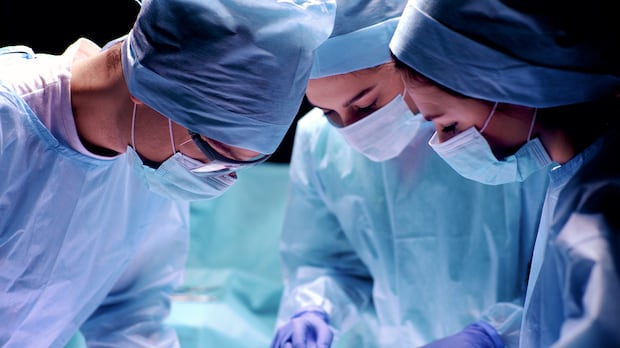Education
Anatomy Education Faces Challenges as Dalhousie Halts Cadaver Use

Dalhousie University in Halifax has suspended the use of cadavers for anatomy education due to safety concerns. Following air quality tests that revealed elevated levels of formaldehyde in the Tupper Building’s anatomy lab, the institution announced it would rely on alternative teaching methods this academic year. Formaldehyde, a known carcinogen, exceeded acceptable standards for Nova Scotia, prompting the school to reconsider its approach to teaching anatomy.
In response to this change, Dalhousie plans to incorporate videos, skeletal materials, and anatomical models into their curriculum. The decision has sparked debate among educators about the value of hands-on experience in anatomy education. For Jessica Byram, an associate professor of anatomy at Indiana University School of Medicine, the experience of working with donor bodies was transformative. She noted, “We always call our donors our student’s first patient,” emphasizing the profound impact such encounters can have on future medical professionals.
Despite the trend toward alternative methods, Byram argues that nothing can replace the experience of working with human remains. She explained that dissecting a lung from a smoker provides visceral insight into the effects of smoking, which is an emotional and educational experience that cannot be replicated through virtual simulations.
Derek Harmon, an advocate for technology in education and professor at Ohio State University, acknowledges the benefits of 3D printing and virtual reality in anatomy instruction. Nonetheless, he believes that these technologies should complement, rather than replace, hands-on experiences. Harmon posed a thought-provoking question: “Would you want a mechanic to learn only through a computer interface?” He underscored the importance of practical skills in developing competent healthcare professionals.
Byram suggests that students should seek surgical rotations to gain real-world anatomy experience. She argues that exposure to a variety of donors allows students to appreciate the complexities and variations in human anatomy, such as the branching of blood vessels and the positioning of muscles.
The conversation surrounding formaldehyde exposure is becoming increasingly critical, particularly as more institutions reconsider their cadaver programs due to health concerns. While some researchers are exploring alternative preservation methods to reduce formaldehyde use, progress is slow, and the supply of donor bodies remains a significant issue.
Dalhousie University has stated that it is exploring new methods for body preservation and considering renovations to the anatomy lab. The university attempted to improve the ventilation system, but subsequent tests indicated that air quality still did not meet the necessary standards. Despite these challenges, Dalhousie continues to accept donations to its human body program while seeking a long-term solution.
Harmon emphasized the need for investment in updated ventilation systems, viewing it as a worthwhile expenditure for the future of anatomy education. He concluded that the hands-on experience of working with cadavers is a vital rite of passage for medical students, one that they are currently missing out on.
In a time when educational institutions are adapting to modern teaching methods, the debate over the use of cadavers underscores the delicate balance between advancing technology and maintaining essential hands-on training in the medical field.
-

 Lifestyle2 months ago
Lifestyle2 months agoWinnipeg Celebrates Culinary Creativity During Le Burger Week 2025
-

 Health2 months ago
Health2 months agoMontreal’s Groupe Marcelle Leads Canadian Cosmetic Industry Growth
-

 Science2 months ago
Science2 months agoMicrosoft Confirms U.S. Law Overrules Canadian Data Sovereignty
-

 Education2 months ago
Education2 months agoRed River College Launches New Programs to Address Industry Needs
-

 Technology2 months ago
Technology2 months agoDragon Ball: Sparking! Zero Launching on Switch and Switch 2 This November
-

 Technology1 week ago
Technology1 week agoDiscord Faces Serious Security Breach Affecting Millions
-

 Science2 months ago
Science2 months agoTech Innovator Amandipp Singh Transforms Hiring for Disabled
-

 Technology2 months ago
Technology2 months agoGoogle Pixel 10 Pro Fold Specs Unveiled Ahead of Launch
-

 Science2 months ago
Science2 months agoChina’s Wukong Spacesuit Sets New Standard for AI in Space
-

 Technology2 months ago
Technology2 months agoWorld of Warcraft Players Buzz Over 19-Quest Bee Challenge
-

 Business2 months ago
Business2 months agoDawson City Residents Rally Around Buy Canadian Movement
-

 Education2 months ago
Education2 months agoAlberta Teachers’ Strike: Potential Impacts on Students and Families
-

 Technology1 week ago
Technology1 week agoHuawei MatePad 12X Redefines Tablet Experience for Professionals
-

 Business2 months ago
Business2 months agoNew Estimates Reveal ChatGPT-5 Energy Use Could Soar
-

 Science2 months ago
Science2 months agoXi Labs Innovates with New AI Operating System Set for 2025 Launch
-

 Technology2 months ago
Technology2 months agoInnovative 140W GaN Travel Adapter Combines Power and Convenience
-

 Technology2 months ago
Technology2 months agoFuture Entertainment Launches DDoD with Gameplay Trailer Showcase
-

 Technology2 months ago
Technology2 months agoGlobal Launch of Ragnarok M: Classic Set for September 3, 2025
-

 Technology2 months ago
Technology2 months agoNew IDR01 Smart Ring Offers Advanced Sports Tracking for $169
-

 Technology2 months ago
Technology2 months agoArsanesia Unveils Smith’s Chronicles with Steam Page and Trailer
-

 Science2 months ago
Science2 months agoNew Precision Approach to Treating Depression Tailors Care to Patients
-

 Business2 months ago
Business2 months agoBNA Brewing to Open New Bowling Alley in Downtown Penticton
-

 Technology2 months ago
Technology2 months agoHumanoid Robots Compete in Hilarious Debut Games in Beijing
-

 Health2 months ago
Health2 months agoGiant Boba and Unique Treats Take Center Stage at Ottawa’s Newest Bubble Tea Shop










